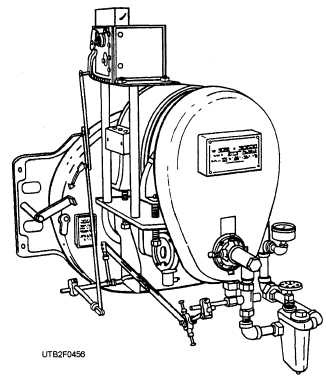
Figure 4-56. - Rotary-cup oil burner.
Clean the nozzles in the shop on a clean bench. A nozzle is a delicate device. Handle it with care. Use kerosene or safety solvent to cut the grease and gum; use compressed air, if available, to blow the dirt out. Use goggles for eye protection when blowing dirt out with compressed air. Never use a Jnetal needle to clean the opening; it will ruin the nozzle. Sharpen the end of a match or use a nonmetallic bristle brush to clean the opening.
When you are checking the nozzle, adjustments may have to be made in the distance of the nozzle from the tube end, the distance of the ignition points ahead of and above the nozzle, and the distance or gap between the ignition points. Figure 4-57 shows these nozzles adjustments. The nozzle tip is set 5/8 inch apart, 1/8 inch ahead of the nozzle, and 1/2 inch above the nozzle center line. These settings are given only for this particular illustration. Actual adjustments should always be made according to the specific settings in the manufacturer's instruction manual. Always tighten electrodes securely to ensure permanent adjustment.
When reinstalling either the pump or the motor, check the coupling to ensure there is no end pressure on the pump shaft as evidenced by lack of end play. If there is end pressure, the coupling should be loosened, moved closer to the pump, and re-tightened.
Troubleshooting When oil burners are operated, operating problems will occur. These problems can cause interruption of service, inefficiency, and damage to the equipment in the system. To ensure proper operation and efficiency, you will need to be able to identify and correct these difficulties. A list of common difficulties and their remedy are contained in appendix II, table L.
Flame Adjustment
After the burner has been visually adjusted and allowed to run about 30 minutes, reduce the stack draft until there is just enough over-fire draft in firebox to keep the pressure from increasing under unfavorable draft conditions. The draft regulator helps Jnaintain a constant draft in the furnace regardless of outside weather conditions. Adjust the draft by properly setting the ad-juster. Too little draft is likely to cause firebox pressure, odors in the building, and possible smoke or smothering of the flame. Too much draft accentuates the effect of a possible leak in the furnace, lowers the percentage of CO2 in the flue gas, and, in turn, reduces the overall efficiency of the unit. After the burner flame and draft are properly adjusted, a flue-gas analysis should show a CO2 content of approximately 10 percent. If it does not, recheck the burner air adjustment and inspect for air leaks. For best results, the flame should be just large enough to heat the building properly in cold weather.
Air supplied to the burner will then be the minimum for clean combustion. If the furnace is large enough and the burner has been set for correct oil flow and minimum amount of air, stack temperature should not exceed 600F. Higher stack temperatures indicate that the fire is too large or the furnace too small, or that there is too much excess air.
Test Equipment
It is almost impossible to set and adjust a burner without instruments or test equipment. Proper instruments, in good working order, must be available in the heating shop for use by personnel who service this equipment.
The draft gauge, usually of the pointer-indicating type, is used to determine suction in the smoke pipe or combustion chamber. Suction is measured in inches of water. Carefully follow the instructions for operating the instrument.
The stack thermometer is used to indicate the temperature of gases in the smoke pipe. Insert the
Continue Reading